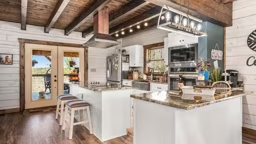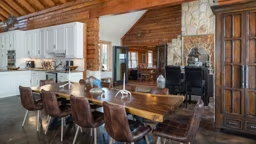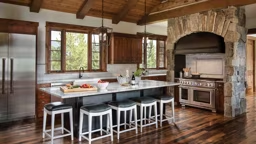Before getting carried away in the frenzy of ever-new and improved products that you’re convinced you cannot live without, however, decide how you and your family intend using your new log-home kitchen. “Plan your kitchen first around how many people you intend to have working, then begin separating the kitchen by zones and workstations,” advises Ines Hani, owner of The Sky Is The Limit Interior Design Concepts, in Victoria, British Columbia. “Recognize that with a log home, the kitchen is always a gathering place where the cook or cooks want to share in conversations while at work.”
Hani identifies six kitchen zones:
- Hot zone.This area contains the ovens, cooktops and other heated cooking appliances, except the microwave, which many designers prefer near the refrigerator.
- Cold zone.This designated food-preparation area should include an additional sink, ample counter workspace and room for clean up. Refrigerators and microwave should be close at hand.
- Island. “Islands are great for creating zones,” Hani remarks. “First of all, they offer a secondary escape route—i.e. if the kids or some other beloved member blocks one way, you can go around the other side. Also, they offer the possibility to create a lower surface, which is ergonomically important.”
- Breakfast zone. Coffee pots, espresso machines and even a child-friendly breakfast areas are often set near a primary or secondary refrigerator for easy access to milk and juice. This is an ideal location for an appliance garage.
- Beverage zone. This area can be a built as a separate bar or integrated simply for overflow.
- Office-desk zone. Setting up a home office right in the kitchen is a convenient way to stay organized. Make sure you have room for phones, computers and a television if desired. This area can be designed to be concealed by cabinets.
Form Versus Function
Because today’s log homes are designed to enhance a feeling of openness between living areas, it’s desirable to have a kitchen where clutter is minimized and continuity is maintained through a well thought-out fusion of natural elements. Warm tones and stylish influences can make all the difference. Here are a just a few companies that have taken to heart extreme functionality with uncompromising design. Jenn-Air recently introduced its Oiled Bronze finish for those who love the sleek and stylish look of stainless steel, yet want the warmth attributed with bronze. The Oiled Bronze finish is available on refrigerators, dishwashers, wall ovens, cooktops and hoods.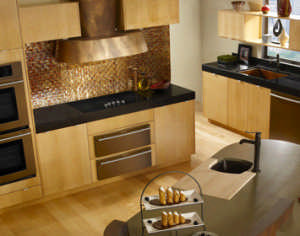 Copper backsplash from Frigo Design
Copper backsplash from Frigo Design
Sub-Zero’s new 700 Integrated series makes refrigeration seamless and practical for use within many work zones. Whether you want drawers, tall cabinets or a combination, this new line is concealed by your own cabinetry and allows for “point of use” refrigeration.
Aga’s refrigerators and ranges offer vivid enamels that can brighten and warm just about any kitchen.
Consider Roseland Icebox Company if you want the latest high-tech refrigerator but prefer an eclectic, Old World appearance. Roseland specializes fabricating specialty wood panels for leading manufacturers that feature hand-forged silicon bronze hardware. In addition, the company builds custom models.
For relief from continuous bands of cabinetry and countertops, YesterTec equips the so-called fitted kitchen with heirloom-looking, handmade furniture or workstations, which easily hold and conceal just about any appliance. There is something for everyone today as we are seeing a revival of retro and antique-styled appliances, as well as the new sleek and simple models. Having a set theme and understanding your space make finding the right furnishings a much simpler and enjoyable process. Whether you like the concept of integrated furniture pieces in the kitchen or prefer a more traditional look, the functionality of what’s inside makes a tremendous difference between having an efficient working environment or one that just looks good.
It Starts With the Cabinets
The dominant ingredient of any kitchen look is the cabinets. Believe it or not, flat cabinets aren’t tricky to hang on round-log walls. They’re typically mounted to wood framing which has been attached to the logs. Lockwood likes to have nice finished ends to the cabinets. “We take 3/4-inch-thick end panels and insert them directly into a chain saw cut that is made in the logs,” she says. “I always use larger end pieces to accommodate for the portion which is inserted in the log.”What about getting the most out of cabinet space? “For those that are not tall enough to reach into those higher cabinets, many are opting to reform this underutilized space by building in vertical dividers to store everything from serving trays to cutting boards,” Hani comments. Another idea is to set upper cabinetry directly on the countertop. “Having it on the counter makes it more accessible to smaller people and children,” Lockwood says. “This works well in kitchens with ample counter space.”
Working pantries and appliance garages do a great job hiding clutter while providing extra dedicated workspace and storage,” remarks Burns Century of Burns Century Interior Design, based in Lawrenceville, Georgia. “They are growing in popularity as people begin to recognize how convenient it can be to have everything needed for a specific task all in one place, such as a baking center or wet bar.” Most drawers are designed to hold a considerable amount of weight, and it’s essential to incorporate high-quality components such as the hinges and glides that can take the usage. “All drawers should be full extension with a quiet close feature, whereby once the drawer is 1 to 2 inches away from closing, the brakes come on and the drawer softly closes itself,” says Ivan Nagode, owner of Ivan’s House of Kitchens and Baths, in Sheboygan, Wisconsin.
Kitchen Counters
Besides cabinets, countertop materials concern most homeowners. With workstations in mind, allow your creativity to flow along a practical course. Mix materials and choose countertop surfaces for their durability, practicality, appearance and price. And, Nagode says, “Don’t be afraid to vary the heights of each work area.”Countertop choices abound:
- Soapstone is growing in popularity for countertops and backsplashes. Unlike other stone surfaces, it is impervious to temperature changes, acids and alkalis.
- Granite captivates most of us with its elegant natural beauty and ability to hide our daily use. Vivid earthtone patterns and a smooth surface make it a favorite for cooking and looking.
- Wood is one of nature’s finest and strongest raw materials. “With wood comes great character and depth and a surface that will last forever if given the proper care,” Century says. But with so much wood already on our walls, we often don’t even think about it on the counter. Take a look at the butcher-block counters, as well as American walnut and teak, which are most commonly used by kitchen designers.
- Quartz’s naturally scratch-resistant, stain-resistant and scorch-resistant natural surface has a solid feel, comparable to natural stone. Silestone, Staron and Cesarstone are brands made from approximately 95 percent quartz and 5 percent polymer resins. They come in a wide array of colors and are virtually maintenance free.
- French pewter countertops, fabricated in Normandy, are built to last for generations. Culinary pewter is a soft metal that is durable and resistant to the elements. The surface is simple to maintain and easy to clean.
- Copper adds timeless beauty and Old World appeal. It’s not for everyone, but when used it can add great character to even the smallest of spaces.
- Zinc is a beautiful alternative to stainless steel. With minimal care, it will age to a distinctive matte patina. Almost anything that is made of stainless can be made from zinc as well.
The Sink
The base of "the work triangle" is the sink. And in today’s log-home kitchen, one is no longer enough. Sinks come in a wide range of sizes, styles and materials. “Don’t underestimate your sink,” Nagode reminds us. “Kitchen sinks need to be large enough to meet your needs as a chef. Select a sink first for its purpose and then base your decision on maintenance issues, which vary with each zone.” The main sink today is likely to be joined by a bar sink and separate prep sink. All are highly functional but can be attractive additions to your kitchen look. For those drawn to a seamless look, for example, consider the manufactured quartz materials, as well as soapstone for combination sink and countertops made of the same material.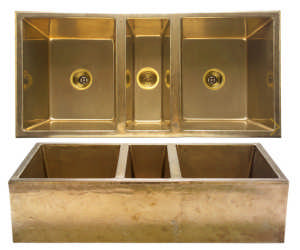 Bronze sink from Rocky Mountain Hardware.
Bronze sink from Rocky Mountain Hardware.
Do you love the appeal of rustic copper? A company called Native Trails makes copper sinks with a variety of finishes. Maintenance is higher on these lovely pieces, but the antibacterial properties are a nice feature. Franke has created a line of granite sinks composed of 75 percent fired granite in a resin composite. It withstands the toughest everyday wear and resists stains, scratches and chips. Sinks are available in interesting colors, such as anthracite, bronze and gold.
Rocky Mountain Hardware’s artisan sinks are forged of solid bronze in a variety of patinas, shapes and sizes. Their self-rimming farmhouse sink is a true kitchen centerpiece with its three basins in one. Fireclay is a traditional ceramic material that is fired at a much higher heat than metal. These sinks are chip resistant and their ultra-smooth dirt repellent surfaces add a soft touch. Professional stainless restaurant-styled faucet units with hose extensions are no longer just for the pros. As the kitchen sink grows in size, these faucets make clean up much easier. Moen, Elkay, Franke and Kohler are just a few of the companies following this trend.
Kick plates installed beneath the sink cabinet are ideal for bakers or busy home chefs who always seem to have their hands in something. Water comes on with just a touch of the foot. Built-in water filters are no longer a luxury. For most they are a necessary add-on for both economical and environmental water purification. Pot fillers are ideal for larger kitchens for people who do a lot of cooking. They are also great for filling built in counter steaming units.
Turning to kitchen refrigeration, do you want to notice your unit and allow its surface to be a focal point for the room? Sub-Zero, Jenn-Air, Viking and Roseland Icebox Company are good places to start. They offer striking appearances in a variety of finishes and styles that reflect the culinary passion of the chef. Are environmentally friendly options preferred? Sun Frost is one of several companies that specialize in energy-efficient refrigerators and freezers. Its models are designed to work from either standard power, solar power or other low-output energy sources. Even in a home using conventional utility power, it typically cuts energy consumption by a factor of five.
Does your kitchen layout require a custom size? Northland, a division of Aga, manufactures a line of custom-sized models available in 6-inch-width increments from 18 to 72 inches. Haier’s chest-size freezer holds 150 pounds of frozen food, and its low height means you won’t get lost reaching for those items stored in the bottom. It also has a manual defrost and defrost drain and an adjustable thermostat. Completing the work triangle is the stove, although today that takes in not just the traditional oven and range, but also specialty cooktops and ovens, including the now-standard microwave.
Convection, induction, gas, microwave and steam—what do they all do? These mechanisms are now being combined into multi-level cooking centers, which have the potential to transform anyone into a gourmet chef. Consider: Will your range be a centerpiece and focal point for the kitchen, or are you looking to save space? Do you need a variety of cooking modes in different locations, or do you prefer them all in one place? Thinking about the answers to these questions can help determine what is best for your needs.
- Convection. Unlike conventional radiant (also called thermal) ovens, convection ovens have a fan that continuously circulates air through the oven cavity. When hot air is blowing onto food, as opposed to merely surrounding it, the food tends to cook more quickly. The rush of heat speeds up the chemical reactions that occur with food and with hot air moving all around the oven, and hot and cool spots are eliminated.
- Microwave. Microwaves work by penetrating food with short electromagnetic waves (shorter than radio waves) that cause liquid molecules in the food to vibrate. This vibration creates friction. The friction produces heat, which in turn, causes the food to cook itself.
- Induction. The actual heat source is the pan, not the cooktop. As the electric current passes through the element below the surface, a magnetic field is created. When a metal pan comes in contact with this magnetic field, its molecules get activated to create heat. When the vessel is removed from the heat source, the induction unit automatically shuts off. Note that pans must be made of a magnetic metal in order for the process to work.
- Steam. Superheated steam is combined with a conventional oven for the purpose of melting fat away for healthier cooking. Steam cooking keeps foods moist without compromising texture and taste at a reasonable price. Gas. Instant heat and precise control make it the choice of chefs and home designers alike. Water vapor produced by gas keeps food moist, and often the ranges themselves are more thematic by design than standard electric models.





